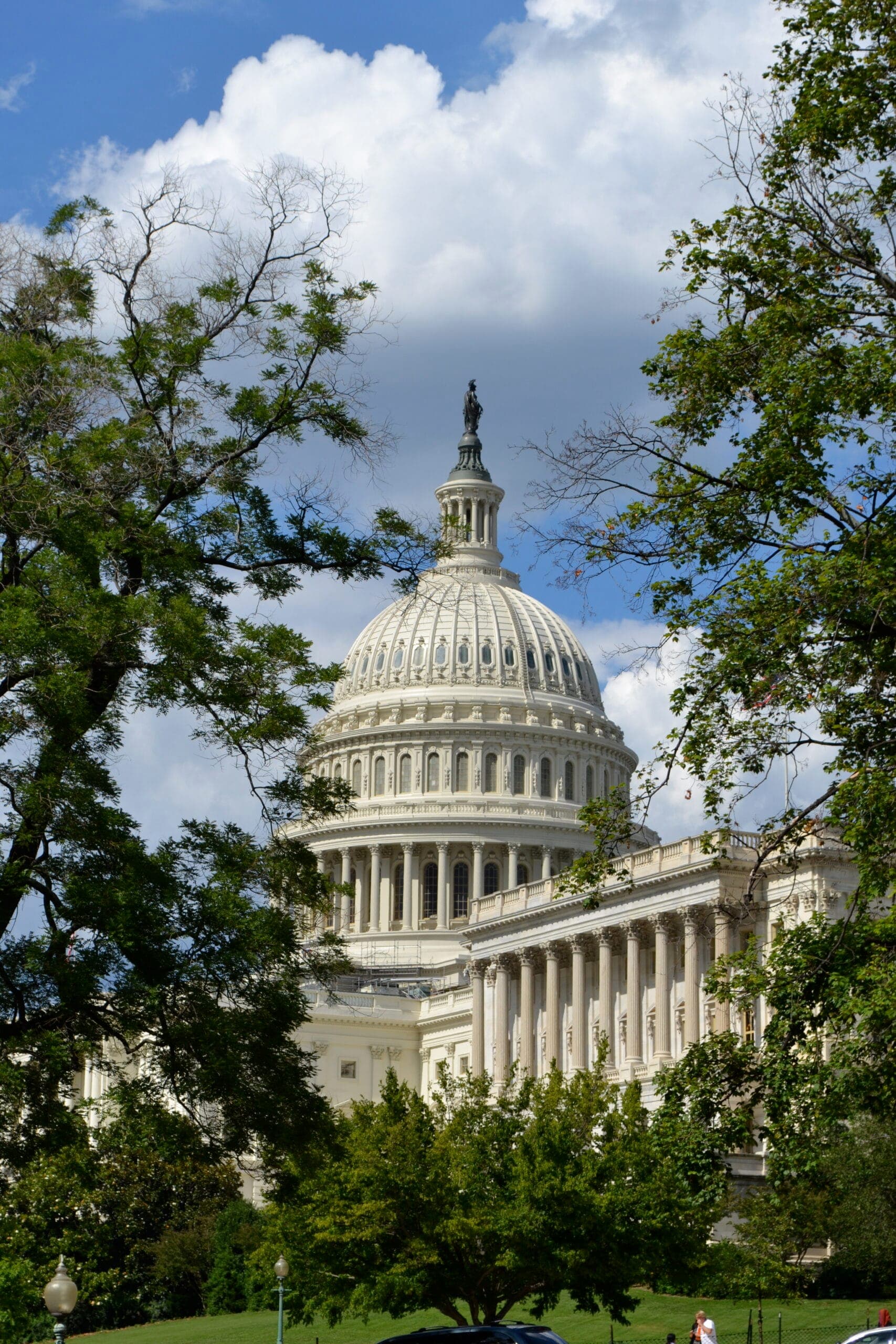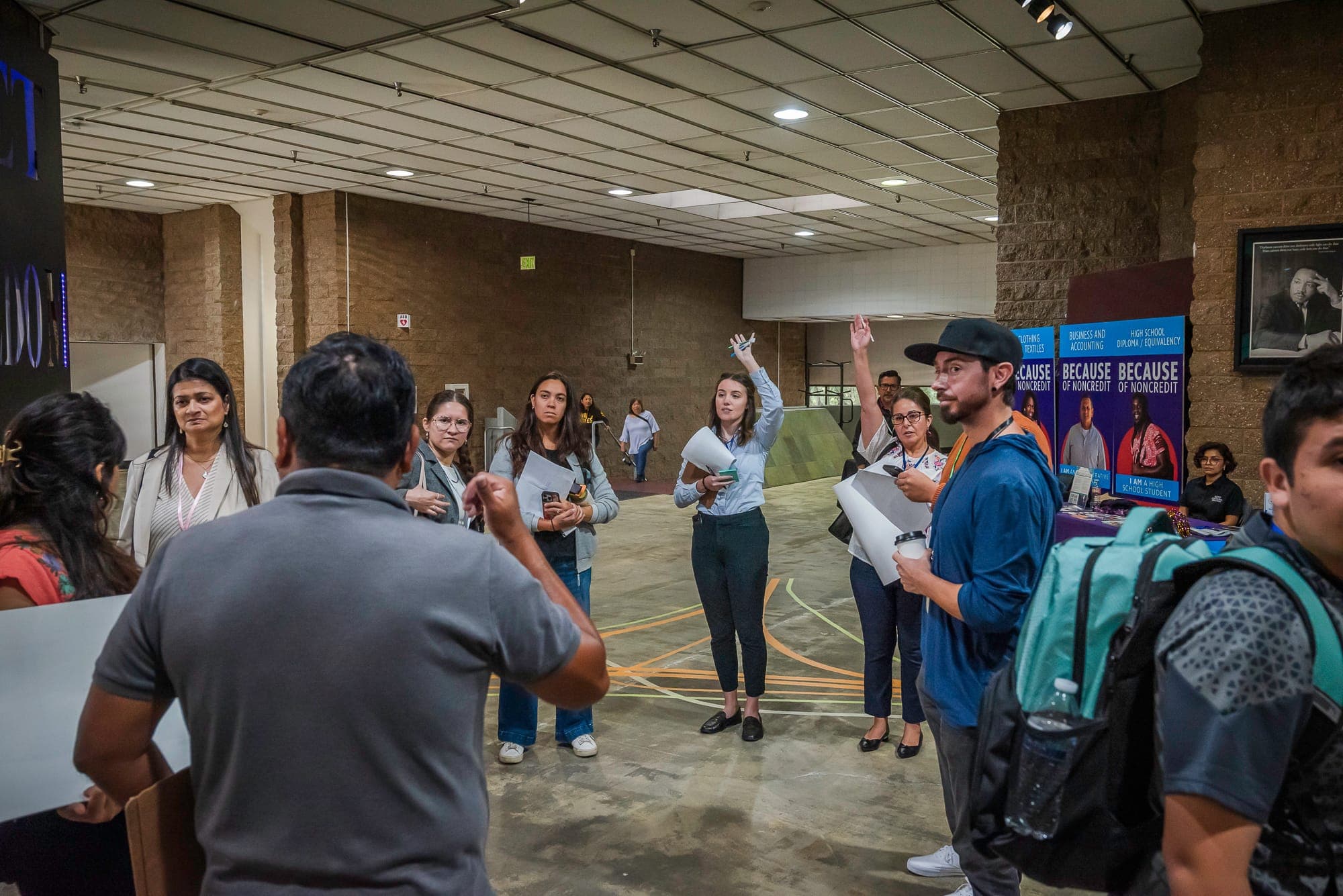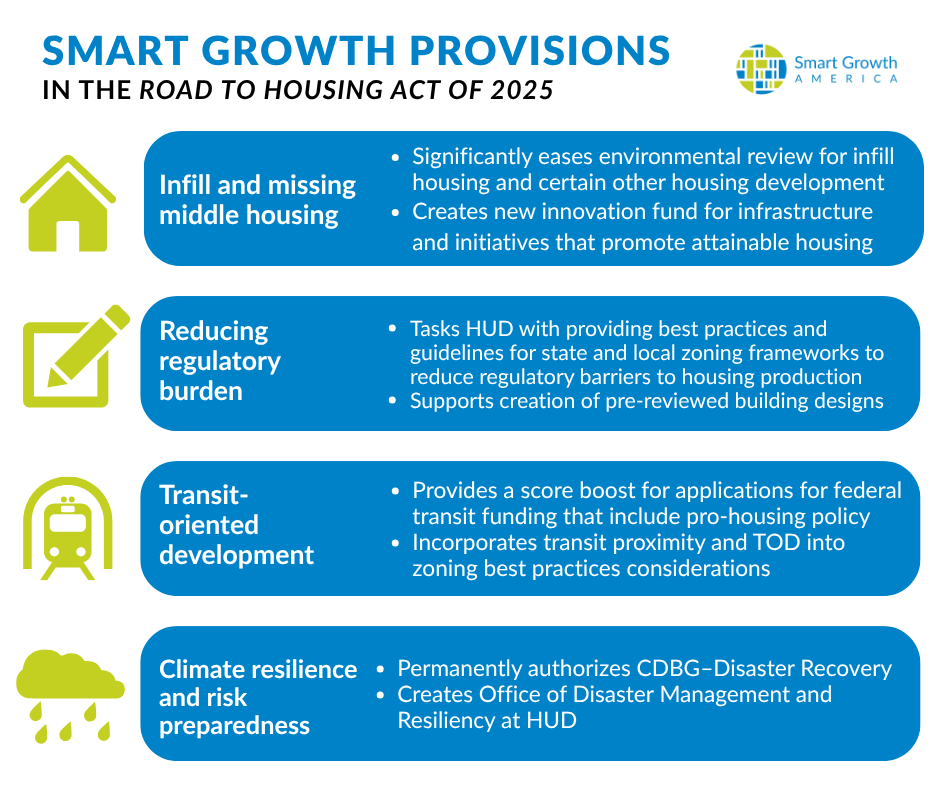
News
By Kennedy O'Dell, July 29, 2025
A new sweeping bipartisan housing package aimed at removing barriers to housing development is set for action in a key Senate committee. What’s in the bill, and can it pass?
Late last Thursday, the Senate Committee on Banking, Housing, and Urban Affairs released a sweeping bipartisan housing package, entitled the ROAD to Housing Act of 2025, and announced their plans to consider it in committee on Tuesday, July 29th. The package includes SGA priority legislation that would promote best practices for zoning and land use, support the streamlining of local housing production through the adoption of pre-approved housing designs, and incentivize pro-housing policies along transit routes. In addition, the expansive legislation would modify or create a number of new programs, implement new provisions to streamline various regulations to remove red tape that limits housing production, and institute a suite of accountability and transparency-focused reforms.
The U.S. is facing its greatest housing affordability and access crisis in generations, and federal leadership is essential to building more homes, supporting affordability, and creating communities where everyone can thrive. New federal programs and resources should seek to reduce regulatory barriers, introduce innovative programs to deliver much-needed housing, and support states and cities to direct housing development to well-connected locations that boost both economic opportunity and quality of life.
The significance of the conscious focus on land use and zoning in the legislation can’t be overstated. The federal government helped shape decades of land use and planning via the 1920s-era Standard State Zoning Enabling Act, but has since played a much less proactive role in influencing land use decision-making at the local level. While there have been forays into the policy space in the interim at the federal level such as the recent creation of the Pathways to Removing Obstacles to Housing (PRO Housing) grant program, the ROAD to Housing Act of 2025 is the first time in decades that Congress has stepped up and embraced the federal role in supporting pro-housing local land use regulations in a sweeping, bipartisan nature. While the future of the package beyond committee consideration is unclear, the bipartisan agreement and momentum for federal land use leadership that incentivizes unlocking housing production through zoning reform is a win in and of itself.
Contact your members of Congress to share your support for the ROAD to Housing Act of 2025, or the provisions you think will have the biggest impact in your community. Let them know how this legislation can help your community build more homes in the right places, improve affordability, and create thriving communities for people to call home.
Land use and zoning provisions
The bill includes versions of three SGA-endorsed bills, two of which were our top land-use priorities for this Congress. The first priority bill, the Housing Supply Frameworks Act, originally introduced by Senators Lisa Blunt Rochester (D-DE), John Fetterman (D-PA), Mike Crapo (R-ID), Thom Tillis (R-NC), and Representatives Mike Flood (R-NE) and Brittany Pettersen (D-CO), would provide resources to communities to help overhaul their local zoning regulations and provide best practices and guidelines for state and local zoning frameworks to reduce regulatory barriers to housing production.
The second priority bill included in the package, the Accelerating Home Building Act, was originally introduced by Senators Lisa Blunt Rochester (D-DE) and Bernie Moreno (R-OH) and would help communities cut through red tape and open new pathways for development by supporting community-driven efforts to create pre-reviewed building designs.
A version of the Build More Housing Near Transit Act was also endorsed by SGA and included in the package. That provision would encourage pro-housing policies along transit lines by providing a score boost for applications for federal transit funding that include efforts like reducing or eliminating parking minimums and minimum lot sizes or increasing the number of homes permitted to be constructed under a by-right approval process for areas along the route. That freestanding legislation was introduced by Senators Brian Schatz (D-HI) and Jim Banks (R-IN), and Representatives Blake Moore (R-UT) and Scott Peters (D-CA).
In other positive land use news, the legislation would also create a new innovation fund, authorized at $200 million per year, that is available to communities that have increased their local housing supply. These funds can be used to support basic infrastructure investments as well as initiatives “that facilitate the expansion of the supply of attainable housing”, which explicitly includes increasing by-right uses, revisions or eliminations of parking requirements, density incentives, streamlining regulatory reviews, and zoning reform more broadly.
Lastly, the bill includes a provision to significantly ease environmental review requirements for infill housing and certain other housing development. To qualify as infill development, this provision explicitly requires that the land be within the geographic limits of a municipality, adequately served by existing utilities and public services, and located on a site of previously disturbed land of not more than 5 acres and substantially surrounded by residential or commercial development to qualify as an infill project. It provides the strongest exclusions for projects that rehabilitate or build 1-to-4 unit residential buildings generally, but also includes exemptions for any infill construction or rehabilitation project, the rehabilitation or construction of projects with 5 to 15 homes, certain office to residential conversions, and acquisitions of open space or residential property for conversion to open space to support the relocation of residents living in high-risk areas. Further reforms to the environmental review process, in future legislation or administrative action, would be a beneficial supplement to the legislation as drafted and would ensure larger-scale housing projects also see some regulatory relief.
Modifications to existing programs and creation of new programs
Beyond the land use-focused provisions, the legislation also includes a wide range of changes and reauthorizations of existing programs and creates new programs focused on investing in existing communities, makes permanent an existing program that assists communities in recovering from disasters, and modernizes a number of important legacy programs such as the Rental Assistance Demonstration (RAD) program and the HOME Investment Partnerships Program.
Among the new programs are two focused on investing in housing for existing communities and preserving existing homes: a new pilot program that looks to stabilize households and neighborhoods by funding basic home repairs, and a pilot program to convert vacant and abandoned buildings into much-needed housing. If funded, these pilots would support smart growth by helping existing homeowners stay in safe and stabilized homes in their neighborhoods and incentivizing the redevelopment and return to productive use of vacant properties.
The bill also provides tools to help communities recover from disasters and prepare for future risks—a key smart growth objective—by permanently authorizing the Community Development Block Grant–Disaster Recovery (CDBG-DR) program, creating the Office of Disaster Management and Resiliency to administer CDBG-DR, and creating a Long-Term Disaster Recovery Fund to provide grants to communities to support disaster recovery efforts. In addition, the bill tasks HUD with promoting best practices in mitigation and resilient land-use planning.
Other provisions focused on making changes to existing programs include:
- Adjustments to the Rental Assistance Demonstration (RAD) program, including removing the cap on the number of units the program can include
- A provision enabling the HUD Secretary to give additional weight to competitive grant applications that are located in or primarily serve a designated Opportunity Zone
- Reforms on the banking and capital side of housing finance, including increases to the Public Welfare Investment cap at the Office of the Comptroller of the Currency (OCC) and the Federal
- Reserve from 15% to 20% in an effort to expand the capacity of banks to invest in affordable housing; an assessment of and potential reworking of multifamily loan limits;
- A provision that seeks to incentivize housing production by adjusting CDBG allocations to provide a bonus for housing production and a 10 percent decrease in CDBG allocations for jurisdictions “below the median housing growth improvement rate.”
- An authorization of HUD’s Preservation and Reinvestment Initiative for Community Enhancement (PRICE) Program, which provides grants to local jurisdictions to support the preservation and stabilization of manufactured housing communities.
- Reauthorizes the HOME Investment Partnerships Program with a collection of reforms
- A provision based on the bipartisan Rural Housing Service Reform Act that would help preserve affordable housing in rural areas by reforming requirements for certain USDA-supported homes
- Authorization for a new Moving to Work cohort, intended to allow an additional 25 public housing agencies to join the flexibility program
- Provisions aimed at reducing homelessness, including adjustments to standing homelessness assistance programs and the creation of a demonstration program to support collaborations between housing providers and healthcare organizations to provide housing-related supportive services
Streamlining and removing red tape
In addition to addressing the way land use regulations limit housing, the legislation also includes a number of provisions aimed at further streamlining different kinds of projects and removing red tape. These include allowing for state assumption of responsibility for environmental review for certain HUD-funded projects, updating the federal definition of manufactured housing, making adjustments to federal housing finance regulations to support the financing of manufactured and modular housing, and provisions aimed at spurring more small-dollar mortgage lending. They also include reforms aimed at expanding the pool of qualified appraisers, streamlining HUD’s inspection process, and provisions to encourage better inter-agency collaboration to improve the efficiency of the delivery of housing programs.
SGA’s take: A key priority of smart growth is removing barriers to what can be built and where. We support efforts to streamline the development process because making it easier and more efficient to build homes lowers costs and ensures more people can benefit from new housing investments sooner.
Accountability and transparency provisions
The final collection of provisions included in the bill is broadly focused on government accountability and transparency. On the program implementation side, these include adjustments to the oversight of housing counseling agencies and counselors, a study of the benefits and challenges of work requirements on public housing agencies, provisions intended to improve veterans awareness of housing financing programs available through the Veterans Administration, and new requirements aimed at supporting consumer-requested second appraisals. On the broader reporting and accountability side, the bill would require annual congressional testimony from specific housing regulators and the Interagency Council on Homelessness as well as create an Inspector General for the Neighborhood Reinvestment Corporation (also known as NeighborWorks).
SGA’s take: Accountability is essential to ensure that programs funded with taxpayer dollars deliver on their promises and provide real benefits to households in need of assistance. We support transparency and oversight measures that help track impact, protect community members, and make sure the housing programs work as intended.
Next steps
The unveiling of the bipartisan legislation and the scheduled markup are significant steps forward for housing policy broadly and the bill specifically, but a long path remains before it is signed into law. After committee consideration, the legislation would need to pass the House and Senate floors, either as a freestanding bill or as an addendum to a larger piece of legislation. Through this process, it could be amended or trimmed down significantly. In addition, the bill doesn’t contain any funding for the grant programs it authorizes–that would instead have to come through a different vehicle, likely either a yearly appropriations bill or a reconciliation bill. The one-two punch required to stand up some of the new programs (authorize, then appropriate) can delay their implementation. Thus, even if passed in committee, the bill will require a sustained push from stakeholders and advocates and further Congressional action to become a reality. Stay tuned to SGA newsletters for updates on the package and reach out to your legislator to highlight the legislation and lay the groundwork for future engagement.
While the path forward remains complex, the introduction and Senate hearing on the legislation is a serious win for smart growth advocates focused on supporting changes in local land use policy and spurring equitable growth in their communities.
Related News

© 2025 Smart Growth America. All rights reserved
Site By3Lane Marketing











